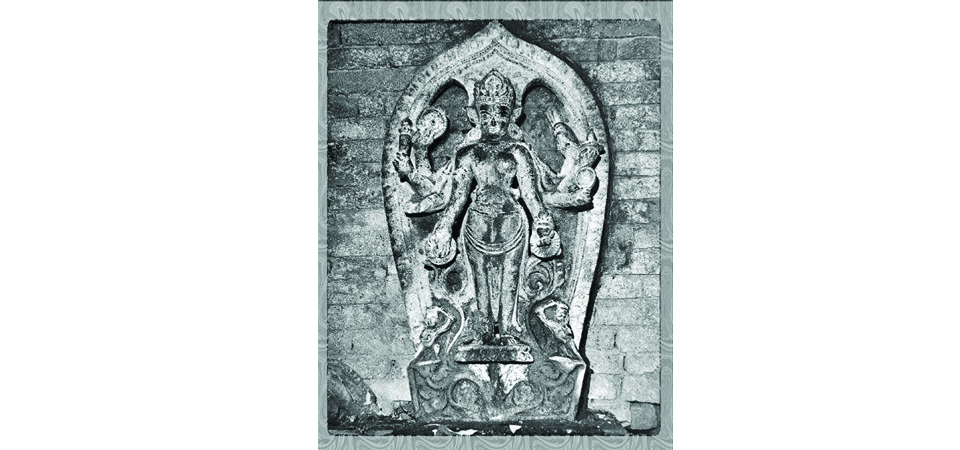Stolen Laxmi-Narayan idol being brought from US

By Aashish Mishra
Kathmandu, Mar. 4: The idol of Basudev-Kamalaja, also known as Laxmi-Narayan, will finally return home, 37 years after being stolen.
The stone figure, which had been stolen from its temple in Patko, Patan in 1984, was located by American artist Joy Lynn Davis at the Dallas Museum of Art last year. Since then, conservationists and heritage activists had been lobbying to get it back.
Heeding the calls and after definitive proof of its origin and conditions of theft, the museum decided to hand over the 70-kilogram statue to the Federal Bureau of Investigation (FBI). The Bureau will deliver it to the Embassy of Nepal in Washington DC on Friday. However, news reports emerged that the embassy would not be able to pay for the idol’s shipment to Nepal. Kumar Raj Kharel, the deputy chief of mission at the embassy, has since rejected the claim, but Lalitpur Metropolitan City (LMC) has now offered to pay for the shrine’s repatriation.
“It is a part of our culture and identity and we want it back at the temple where it belongs,” Mayor Chiri Babu Maharjan told The Rising Nepal. “I talked to Foreign Secretary Bharat Raj Paudyal on Monday who assured me that he would coordinate with the Nepali embassy in the United States of America. After that, the Ministry of Foreign Affairs will get back to us with the details on how to proceed.”
Maharjan adamantly stressed that the statue would be placed at its original location in Patko. The metro had also held a meeting with local representatives, conservationists and other stakeholders on Sunday where everyone called for the idol to be restored to its original location rather than a gallery or a museum.
“We will use modern technology and coordinate with the locals to guarantee its security but there is no question that the deity has to be placed at the temple,” Maharjan stated.
Nirmal Ratna Shakya, chairman of LMC ward no. 16 where the temple is located, shared that the ward would facilitate its restoration and security. “Once the LMC initiates the process of bringing our god back, we will hold a meeting with the locals and the security agencies about holding the proper forgiveness worship (Chhyama Puja), re-establishing it in the temple and ensuring that it does not get stolen again,” he said.
Meanwhile, the people are jubilant at the prospect of getting the shrine back. Local elder Sarwa Man Shrestha remembers the women of his house visiting the temple every morning to worship Laxmi-Narayan. “It had been in the community for more than eight centuries. It was an integral part of our culture, religion and festivals. You can say that it was a part of us,” he expressed. “My mother wept for hours when the statue was stolen. Everyone in the neighbourhood was tormented,” Shrestha, 72, recounted.
“Thank the divine soul that found it in America and thank the LMC for working to bring it back,” Shrestha poured praises to Mayor Maharjan for taking the initiative to retrieve this “national treasure,” as he called it. “May the people who stole our god never find peace, even in the afterlife.” There are hundreds, if not thousands, of stolen artefacts from all over Nepal in private collections, galleries or museums all over the world. Occasionally, some pop up in public and pleas for repatriation are made. However, unless the federal government takes an initiative, the local levels rarely make an effort. This is what Chiri Babu Maharjan wishes will change. “These constitute our history and identity and we must make every possible effort to bring them back. Hopefully, LMC’s actions will stand as an example,” he wished.
At the same time, LMC is working towards forming a committee to bring back other stolen and smuggled antiques of the city. “We have the faith that the government will recognise this committee and support its work,” Maharjan said.
The image of the 12th-century androgynous composite figure was published in art historian and novelist Lain Singh Bangdel’s book ‘Stolen Images of Nepal’ in 1989. With the original gone, the locals had installed a replica at the temple.
Recent News

Do not make expressions casting dout on election: EC
14 Apr, 2022
CM Bhatta says may New Year 2079 BS inspire positive thinking
14 Apr, 2022
Three new cases, 44 recoveries in 24 hours
14 Apr, 2022
689 climbers of 84 teams so far acquire permits for climbing various peaks this spring season
14 Apr, 2022
How the rising cost of living crisis is impacting Nepal
14 Apr, 2022
US military confirms an interstellar meteor collided with Earth
14 Apr, 2022
Valneva Covid vaccine approved for use in UK
14 Apr, 2022
Chair Prachanda highlights need of unity among Maoist, Communist forces
14 Apr, 2022
Ranbir Kapoor and Alia Bhatt: Bollywood toasts star couple on wedding
14 Apr, 2022
President Bhandari confers decorations (Photo Feature)
14 Apr, 2022









